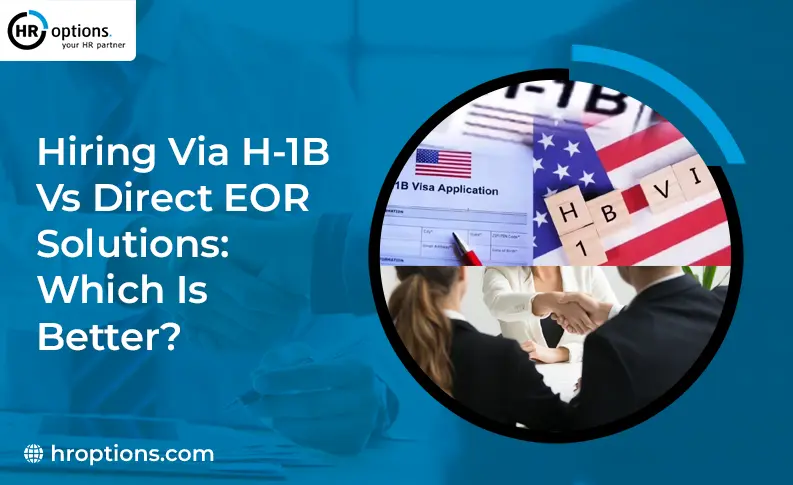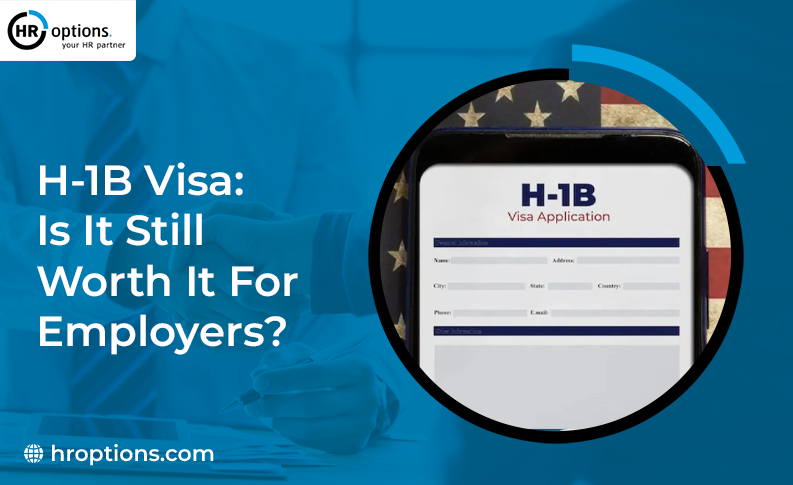Finding the right talent shouldn’t drain your hiring budget. Many companies face this challenge when they try to hire international professionals through the H-1B visa program. Between application costs, attorney fees, and relocation expenses, that “$100K hire” can become a reality fast. The good news is that you can hire top global talent without paying $100k for an H-1B visa.
Using an employer of record (EOR) removes visa and entity complexities. Hiring international freelancers or consultants provides you with short-term expertise. Setting up a global subsidiary or offshore team supports long-term growth. Each option offers a distinct route. You get broader talent access. You reduce cost and risk. You build a truly global workforce.
What the $100K H-1B Fee Means for Employers and Workers?
First, let’s break down why the costs and risks are mounting.
- Caps, lotteries, and unpredictability: The H-1B program is capped at around 85,000 positions come new visa time annually (including 65,000 general cap plus about 20,000 for holders of U.S. advanced degrees). That adds real strategic risk for hiring plans.
- Cost: You’re not just paying for the visa application. Legal counsel, filing fees, immigration paperwork, relocation for the employee, possibly housing, and travel all add up. A recent article states that new fees alone can push sponsorship costs into six figures.
- Time delays and administrative burden: Between filings, approvals, labor condition applications, and waiting for consular processing, you may wait months before your hire can start. That can delay projects and disrupt momentum.
- Strategic risk: Rules can shift. For example, sponsoring employers must meet obligations, maintain certain wage levels and locations, and file amendments when work locations change. The combination of immigration risk and regulatory exposure means the H-1B path is less stable than it once was.
Given all that, many companies are thinking: maybe there’s a better, leaner way to tap into global talent.
Exploring Alternatives to H-1B Hiring
Here are four solid options to consider when you want global talent without the hefty visa bill.
Option 1: Using an Employer of Record (EOR)
If you appreciate the benefits of hiring internationally but want the legal safety net and structure, an Employer of Record (EOR) can be the ideal solution. Here’s how it works: you direct the person’s day-to-day work. The EOR legally hires them in their country, handles local employment contracts, taxes, benefits, and compliance.
Here’s why this can replace H-1B sponsorship:
- No long immigration files and visa approvals. Since the worker remains in their home country and is employed locally, there’s no U.S. visa sponsorship required.
- Faster setup — weeks instead of months.
- Cost savings and lower risk: fewer relocation or immigration-legal costs, fewer surprise obligations.
How to choose a top EOR provider?
- Confirm geographic coverage: Does the EOR operate in the country where the talent lives?
- Check their compliance track record—local labor laws, tax obligations, benefits management.
- Understand pricing: clear, no hidden fees.
- Ask about support for scaling as you build out more global hires.
EOR is a strong middle path: you manage talent like yours, but avoid many of the legal hurdles associated with immigration.
Option 2: Hiring Through Global Remote Work
Hiring remotely from the talent’s home country eliminates location and relocation costs. You will gain access to global expertise that remains rooted in their existing location, where they already live and work.
Benefits include a broader candidate pool, faster onboarding, and lower upfront costs. For example, companies are turning to remote hiring because it offers immediate access to global talent without the risks associated with a traditional hiring process.
To do this well, you’ll need the right tools and approach:
- Use platforms like Deel, Remote, or Papaya Global that support cross-border payroll, tax compliance, and contractor management.
- Communicate clearly, considering time zones, language, and expectations.
- Ensure employment or contractor status aligns with local law in the talent’s country.
- Focus on outcome-based metrics rather than assuming “onsite equals productive.”
When set up properly, remote global work becomes a major advantage.
Option 3: Contracting International Freelancers or Consultants
If you don’t need a full-time employee but require expertise for a specific project, freelancers or consultants may be the solution. Like if you need someone for a specific project or an expert for a six-month period, that’s where contracting international freelancers or consultants makes sense.
Platforms like Upwork, Toptal, or Freelancer give you access to global specialists in software, marketing, design, whatever you need.
Key considerations:
- Establish clear contracts that cover deliverables, timelines, and ownership of intellectual property.
- Use payment platforms with escrow or verified systems.
- Review country-specific legal risks: freelancer vs. employee classification, tax liability, and data privacy.
- This option is ideal for short-term, flexible work, but may not be suitable for long-term roles that require continuity, benefits, and alignment.
Freelancers let you move fast. However, for roles that matter long-term to your business, you may want the stability and alignment that full-employment or EOR models provide.
Option 4: Setting Up a Global Subsidiary or Offshore Team
If you’re scaling and building an international hub, setting up a subsidiary or dedicated offshore team could make sense. This gives you direct control, local employment status for workers abroad, and more integrated operations.
When is setting up a subsidiary or offshore team a good idea?
- If you need a large group of workers, recurring projects, or a sustained overseas presence.
- When cost arbitrage, time-zone coverage, or market access justifies the setup.
Considerations by region:
- Latin America: Near-shore time zones (especially for the U.S.), strong bilingual talent, generally favorable cost structure.
- Eastern Europe: Excellent engineering talent, good alignment with Western culture and markets; payroll and benefits may cost more than Asia, but quality is often higher.
- South Asia: Massive skilled pool, low cost, strong technology skills; but the time-zone gap to the U.S. may matter, and managing teams across geographies requires good process.
Before you dive in: compare cost, legal/regulatory ease, time-zone fit, language and cultural alignment, and infrastructure. Keep in mind that setting up a subsidiary has a higher upfront cost (legal entity, local HR, payroll setup) than remote or EOR models. But if you scale large, the per-head cost may become more favorable in the long run.
Conclusion
Finding and hiring global talent doesn’t mean you’re locked into spending $100,000 or more on an H-1B visa. By embracing alternatives such as remote work, EORs, freelancers, or setting up overseas teams, you gain flexibility, reduce risk, and access skilled professionals worldwide. The key to hiring top global talent without paying $100k for an H-1B visa is aligning your hiring model with your business rhythm.
Project-based work suits freelancers, core roles fit EOR or remote employment, and scaling operations may justify establishing a subsidiary. Choosing a well-managed global talent strategy means you’re not just chasing availability—you’re building a talent pool that serves you now and into the future. If you’re looking for the best EOR services, HR Options is your go-to partner for hiring global talent efficiently without H-1B hurdles.








